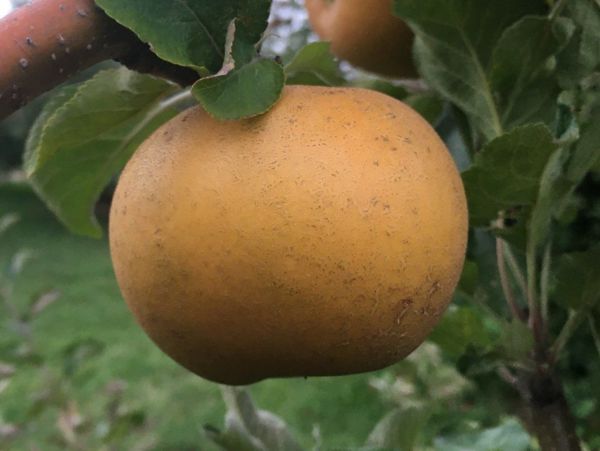An attractive, highly disease-resistant apple, ideal for organic growers.
St. Edmund's Russet Apple on G.890 (Spring 2024)
A mid-season heirloom russet with a rich pear-like flavor . Also known as St. Edmund's Pippin.
This tree is annual bearing and low vigor, with an upright but droopy habit. It is tip bearing, so care should be taken when pruning. Very easy to grow, St. Edmund's Russet is resistant to powdery mildew, scab, cedar-apple rust, and canker. Of all the major diseases, it is susceptible only to fireblight. Although it is partially self-fertile, better crops will be obtained from this tree in the presence of a pollenizer.
The mid-season apple is flattish and fully covered in a smooth, velvety, pale fawn russet. The flavor is exceptional when fully ripe. In Apples of Uncommon Character, Rowan Jacobsen writes: "Like vanilla pudding infused with pear essence. Early in the season, the richness can be masked by a blast of lemony acid, but this gives way to a yellow-cake flavor." The texture is finely grained, crisp, and meltingly delicate. St Edmund's Russet is not a storage apple; eat it quick!
Originating from the town of Bury St. Edmunds in Suffolk, England, this apple was first raised by a Mr. R. Harvey in the late 1800s. It was popularized in the 1900s by Bunyard's Nursery of Kent, and in 1993 it won the Royal Horticultural Society Award of Garden Merit. The eponymous Saint Edmund was a devoutly Christian ruler of East Anglia who was killed (at great length) by some invading Danes in 870. In Christian iconography he is portrayed with a sword and arrow, the instruments by which he was tortured.
The Fruit
Fruit Type
Category: Apple
Subcategory:
Heirloom, Cider, Disease-Resistant
Fruit Uses & Storage
Uses: fresh eating, cider
Cider classification: sharp
Storage duration: less than one month (approximate, depending on storage conditions)
Fruit Appearance
Skin color: russeted
Flesh color: cream
Fruit Origins
Parentage: unknown
Origin: Bury St. Edmunds, Suffolk, England
Introduced in: 1875
Introduced by: R. Harvey
The Environment
Calendar & Geography
USDA zones: 5 - 7
Chill hours: 700
Ripening date: Sep 15 (approximate, in New York State) + 0 days after McIntosh
Tree Height & Spacing
glossary
Rootstock: G.890 Rootstock
Rootstock size class: Half-Standard (60% of Standard)
Tree spacing (natural spread of tree): 18'
Good for wildlife planting? N
Diseases & Pests
glossary
Fireblight: Susceptible
Powdery Mildew: Resistant
Apple Scab: Resistant
Cedar-Apple Rust: Resistant
Perennial Canker: Resistant
Pollination
Pollination Factors
glossary
Bloom group: 2
Is it self-fertile? N
Is it fertile? Y
Ploidy: Diploid
Rootstock size class:
Half-Standard (60% of Standard)
Pollination Partners
This table shows the first few results from a full search for pollenizers of St. Edmund's Russet Apple on G.890. Please see our Pollenizer Search to run other queries and read how the application uses various factors. Also read more about fruit tree pollination.
See all pollination matches for St. Edmund's Russet Apple on G.890
Featured Products
A few things we're loving right now...
A full-flavored, freestone white peach.
One of America's oldest apples, good for storage, baking, and cider.
A widely-grown, large, yellow-fleshed nectarine.




















